
17 minute read
EDQ WILL TRANSITION TO ELECTRONIC FORMAT IN 2022
ABOUT ROTAVIRUS
Rotavirus diarrhea is a very serious, life threatening disease in foals usually caused by Rotavirus Group A viruses. Adult horses are not typically affected by it. Rotaviruses are highly contagious between susceptible animals. Vast numbers of virus particles are shed in the diarrhea of affected animals, but only small numbers of virus particles are needed to cause disease via fecal-oral transmission. Typically, different rotavirus groups and strains infect specific species, however, it has been documented that strains can ‘jump’ species, making it possible for strains not typically associated with humans to infect people. As such biosecurity precautions should always be taken when working with animals with diarrhea.
Advertisement
CLINICAL SIGNS
Rotavirus diarrhea in susceptible foals causes watery diarrhea, anorexia as the foal stops nursing, abdominal distention usually due to gut inflammation, transient gut stasis and often colic. Massive fluid and electrolyte loss through diarrhea, as well as not nursing, causes rapid and severe dehydration and electrolyte derangements that can be fatal. Susceptible, infected foals will show signs of disease as young as 24-48 hours of age.
ROTAVIRUS EFFECTS ON THE GUT
The virus damages the mature cells of the small intestine at the tips of the villi (microscopic fingerlike projections that increase gut surface are for digestion and absorption). This massively reduces the foal’s ability to digest milk, especially the milk sugar, lactose, leading to maldigestion and malabsorption. It can also create an environment in the gut that can allow pathogenic bacteria to overgrow, possibly creating other problems.
The severity of disease depends on the foal’s age, immune status and the number and virulence of rotavirus particles ingested. Typically, younger foals are more severely affected.
TREATMENT OF ROTAVIRUS DIARRHEA
Treatment is supportive with the mainstay of treatment being intravenous fluid therapy. This allows foals to maintain their hydration and electrolyte balance, and are administered by or under the guidance of your veterinarian. In very young foals, your veterinarian may also place the foal on prophylactic antibiotics to help prevent bacteria in the gut translocating across the inflamed gut wall and causing a joint infection, for example. Since rotavirus is a viral infection, antibiotic therapy does not treat the infection directly. Your veterinarian may also place the foal on gastric protectants to reduce the chance of gastric ulcer development. In some cases, not allowing or strictly limiting nursing can be beneficial but must only be done
in conjunction with your veterinarian or at a veterinary hospi-
tal because such young foals are so dependent on nursing for their hydration and energy needs, and they require intensive care should nursing be restricted.
PREVENTION
Strict hygiene and biosecurity are essential to prevent the spread of rotavirus among foals. No ‘one size fits all’ biosecurity protocol exists and as such designing one for your farm is a team effort between you and your veterinary team.
Common basic hygiene which includes wearing gloves and clean protective clothing to handle foals, using foot dips with an appropriate disinfection outside stalls, dedicated footware for foaling barns, reducing animal, human and vehicular traffic in barns and between barns, not using leaf blowers or power washers in barns with horses in them, are just a few items among many to consider in a protocol.
DISINFECTANTS
Bleach is not an appropriate product to use in a farm/barn situation. Its activity is too easily destroyed by organic material to be in any way, shape or form effective. Peroxygen compound or Phenolic compound disinfectants are recommended. A list of such compounds may be found here but it is important to read the instructions. Examples of such disinfectants include Rescue®, Oxy-Sept 333®, Virkon-S®, One Stroke Environs®, Pheno-Tek II and TekTrol. (The University of Kentucky does not endorse or promote any commercial products. These names are for informational purposes only.)
Additional resources relating to biosecurity measures may be found
When thinking about disinfection please remember: • to clean surfaces of grease and organic debris • replace foot dip container disinfection solution frequently to prevent inactivation by organic debris • to mix the correct dilution of disinfectant solution carefully – stronger is not always better! • to allow sufficient contact time for disinfection
VACCINATION
Zoetis® offers a Rotavirus Group A [G3 strain] vaccine for the administration to mares using three doses given at months 8, 9 and 10 of gestation during each and every pregnancy. This vaccine has been immensely helpful in preventing neonatal Rotavirus Group A diarrhea in foals. However, we do see Rotavirus Group A (G3 and G14 strains) as a cause of diarrhea in older foals, aged 75-120 days of age. At this age the disease is typically mild and self-limiting with minimal veterinary intervention required. Foals typically recover completely from rotavirus infections with timely veterinary care and supervision.
EQUINE ROTAVIRUS B
During the season of 2021, a new rotavirus strain, Equine Rotavirus B, was identified in neonatal foals affected with severe watery diarrhea. The discovery of this virus was the result of a massive collaborative effort between our farm and veterinary community and researchers at the University of Kentucky Gluck Equine Research Center and Veterinary Diagnostic Lab.
Research into this virus continues with the ultimate goal of being able to generate a vaccine to help prevent Rotavirus B neonatal disease in foals.
OUR RECOMMENDATIONS FOR THE PREVENTION AND CONTROL OF THIS DISEASE ARE THE SAME AS FOR ROTAVIRUS GROUP A PENDING FURTHER INFORMATION AT THIS TIME. WE CANNOT STRESS HIGHLY ENOUGH THE NEED FOR PROPER BIOSECURITY PROTOCOLS ON YOUR FARMS AS THE CRITICAL TOOL TO PREVENT AND CONTROL INFECTION.
Understanding rotavirus and its prevalence in our equine population is important for us to gain traction with this disease and gain leverage to win research grants to continue our work.
We encourage you to test fecal samples from foals with diarrhea in consultation with your veterinarian (please chill the sample and submit the same or next day). The University of Kentucky Veterinary Diagnostic Lab offers single or combined qPCR tests for Rotavirus A strains [G3 and G14], as well as the novel Equine Rotavirus B.
We wish you every success for the 2022 season. Please contact us if we can help you or your veterinarian.
Contact: Gluck Equine Research Center: Emma Adam, emma.adam@uky.edu
EQUINE DISEASE QUARTERLY WILL TRANSITION TO ELECTRONIC FORMAT IN 2022
Since its inception in 1992, the Equine Disease Quarterly has been distributed worldwide in a printed format. The funding to make this possible was provided through the generosity of Lloyd’s of London, Underwriters and Brokers and their Kentucky Agents, and in later years, by Underwriters at Lloyd’s, London. Circulation of the Quarterly went from several hundred copies in October 1992, to approximately 17,000 copies in 2021, and reached readers in over 87 countries. In late 2020, Lloyd’s Underwriters confirmed that because of changing circumstances, it could no longer sustain support of the Equine Disease Quarterly beyond 2021. Thankfully, a new sponsor, Equus Standardbred Station, Inc., recently came forward and generously agreed to help the continued distribution of this worthwhile publication. This recent development provides a long overdue opportunity to bring about a change in how the Quarterly can best be made available to its readership. Considered opinion is to transition from mailing print copies to an electronic format, where each issue is available on the internet. This will have the important advantage that once each issue is posted, it will be immediately available to the readership with a link to a pdf for downloading or printing. In time, this will likely give rise to an increase in circulation of the Equine Disease Quarterly among veterinarians and equine stakeholders, especially since the publication is available at no charge and material published is not subject to copyright. While the distribution of future issues of the Quarterly will change to an electronic format, the purpose of the publication will remain the same as was stated in the Commentary of the first issue, October 1992. It is to provide information on the incidence of particular diseases/syndromes and the emergence or re-emergence of previously unreported diseases. This will apply to outbreaks occurring in Kentucky, the USA, and other parts of the world. It will also serve as a reference source of the latest information on disease prevention and control strategies. In preparation for the upcoming changes in how the Quarterly will transition into an electronic format, those currently receiving printed versions of the publication are strongly encouraged to review the information provided as follows and return their responses by no later than November 15, 2021. To continue receiving the Equine Disease Quarterly, please scan the QR code or go to the following link. In a brief survey, you’ll be asked to provide your e-mail address, as well as your name and mailing address as print-
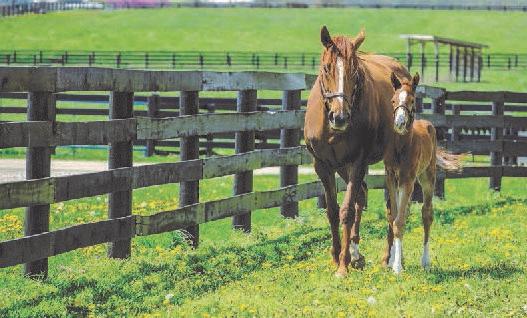
PHOTO COURTESY UK COLLEGE OF AGRICULTURE, FOOD AND ENVIRONMENT.
ed on the Quarterly. Please reply by November 15, 2021, to continue receiving your issue without interruption. Thank you for your ongoing interest in receiving the Equine Disease Quarterly.
| Peter J. Timoney, MVB, MS, PhD, FRCVS, Frederick Van Lennep Chair in Equine Veterinary Science at the Gluck Equine Research Center.
BREEDERS’ CUP 2021: HOW THE RSTL AND UK RESEARCH WORKED TO IMPROVE THE DEL MAR SURFACES
UPGRADED DAILY TESTING, NEW DATABASE
The best surfaces, whether dirt or turf, perform consistently from day to day, year to year and for every stride of the horse. During the 2021 Breeders’ Cup hosted at Del Mar, the independent non-profit Racing Surfaces Testing Laboratory (RSTL), with its research partner, the University of Kentucky College of Agriculture, Food and Environment, will usher in a new era of standardized measuring protocols and data management that will help improve the consistency of racing surfaces. The RSTL will use Del Mar as a beta test site during the Breeders’ Cup for its upgraded daily testing, developed in collaboration with UK and new database developed in collaboration with The Jockey Club. More accurate daily testing equipment for both dirt and turf will be combined with real-time data collected from maintenance equipment during racing. Especially in low humidity environments, additional data on the moisture content of the dirt racetrack during the race card can facilitate improved surface consistency. Moisture, racing and training and equipment traffic all change the track; the RSTL’s Maintenance Quality System mitigates those effects by taking a series of daily and longer-term standard measurements that are added to a database to allow for comparisons between 14 leading North American racetracks and coordination of efforts to minimize adaptation by Breeders’ Cup horses to a new surface.
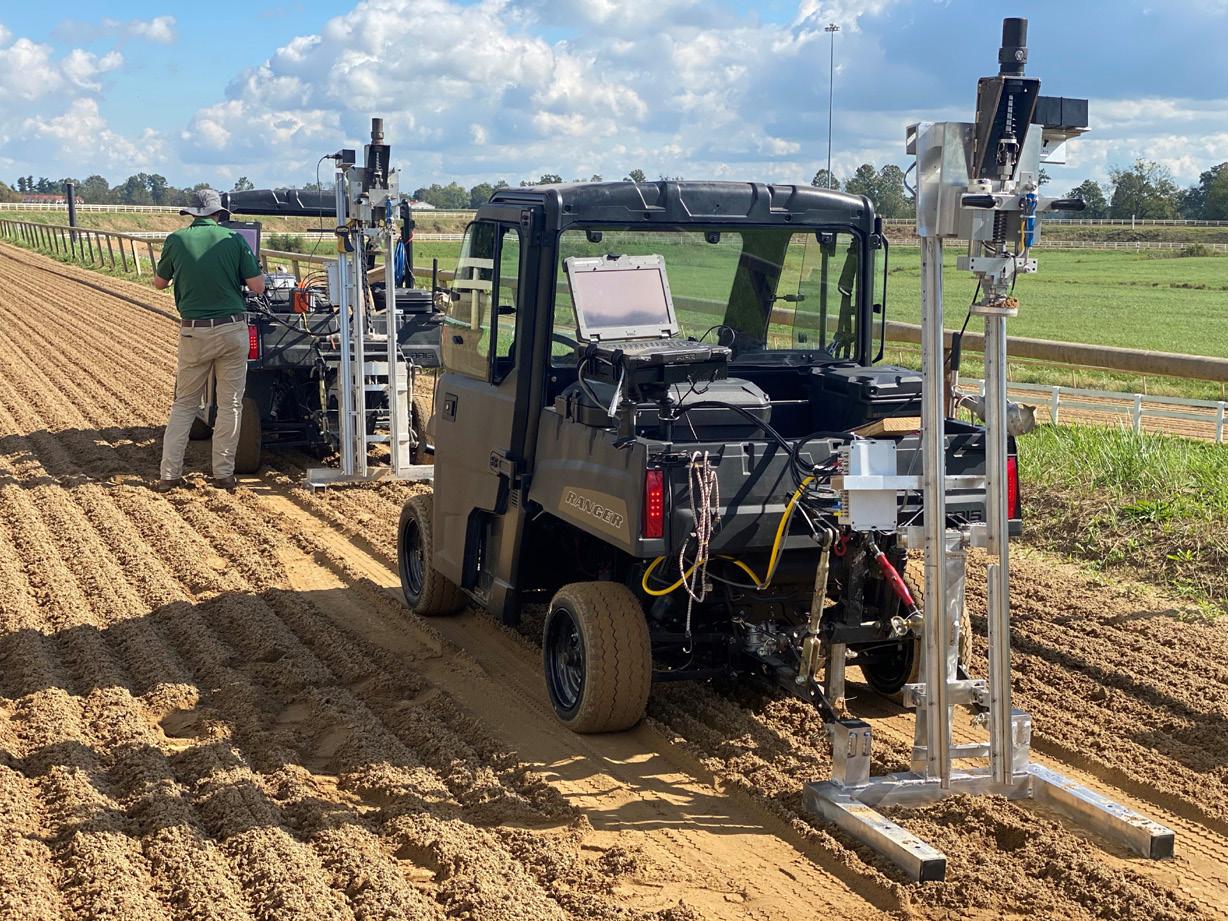
PHOTO COURTEY DR. MICK PETERSON.
HOW THE MQS TESTS THE SURFACE BEFORE RACING STARTS
Biomechanical surface testing, ground penetrating radar and composition testing are conducted before horses are allowed to train or race on a surface to ensure the racetrack is ready for use. During a one- to two-day review period, equipment is inspected, electronic infrastructure is updated and the racing surface is tested. During biomechanical surface testing a robotic horse is used to replicate the loads and speeds of a Thoroughbred at a gallop. This machine is used to determine if the surface is consistent and provides the same vertical and horizontal loads on the leg as other tracks that participate in the Maintenance Quality System. The comparisons include the Del Mar racetrack, as well as other racetracks used by Breeders’ Cup horses, including New York Racing Authority, Keeneland, Churchill Downs and Santa Anita. Ground penetrating radar is used to inspect the cushion and base, which supplements grade checks performed by the track maintenance crew. A total of 12 tests are performed on the sand used on the surface to ensure that it is consistent.
HOW THE MQS TESTS THE SURFACE DURING RACING
Measurements taken before racing starts are only part of the effort. Every race day, changes in material and moisture must be controlled. Divots are repaired on the turf course; the dirt track is graded; and real-time weather data is transmitted from the track at 15-minute intervals. Moisture and cushion depth are measured daily on the main track. Daily measurements of
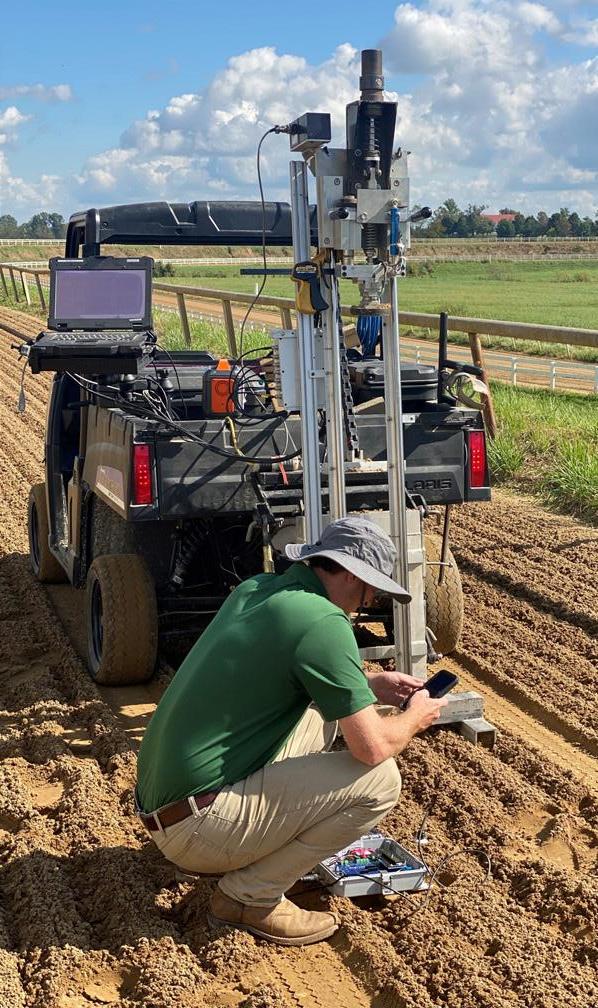
PHOTO COURTEY DR. MICK PETERSON.
moisture and “going” are made on the turf track. These checks ensure the consistency of the maintenance and provide information which can be used for making training and racing decisions.
ABOUT DEL MAR’S RACING SURFACES AND PERSONNEL
Del Mar has two racing surfaces: a one-mile dirt main track and a 7/8th-mile inner turf track. The main track has 85% medium to fine sand and 15% silt and clay. The turf track has a sand profile with fiber reinforcement growing a hybrid Bermuda grass. Two experts work closely to ensure quality racing surfaces on both tracks. Dennis Moore, racetrack superintendent, is a second-generation racetrack superintendent with 50 years of experience in racing. Leif Dickenson, who oversees the track superintendent, is an agronomist who also has decades of experience on racetracks and other equestrian surfaces. Both Moore and Dickenson were integral to the development of the Maintenance Quality System and have participated since its inception. During Breeders’ Cup they will be assisted by Kaleb Dempsey, an engineer at the Racing Surfaces Testing Laboratory, and Mick Peterson, a professor within UK’s Department of Biosystems and Agricultural Engineering and co-founder of the Racing Surfaces Testing Laboratory.
| Karin Pekarchick, MS, senior extension associate for distance learning in the UK Department of Biosystems and Agricultural Engineering and founder of the UK Female Equestrian Health and Wellness Community of Practice, and Mick Peterson, PhD, professor of biosystems and agricultural engineering in the College of Engineering, provided this information.
As a follow up to a recent survey, researchers invite you to take part in a survey about horse farm operations and use of conservation practices. The purpose of this study is to understand motivations and barriers to the implementation of conservation practices on Central Kentucky horse farms. Through this study, we hope to improve water quality in Central Kentucky and better understand horse farm concerns. Interested participants will be asked to take a 15-minute survey.
You may be eligible to participate if you: • Are over the age of 18 • Own or manage a horse farm in Central Kentucky
Visit this site to learn more. For more information, contact: Steven Evans Kentucky Water Resources Research Institute steve.evans@uky.edu 859-327-6601
The end of the growing season is approaching or has come. The release of the new climate normals earlier this spring means we also have a new set of frost/freeze normals. In doing so, I looked at the average first freeze date for various locations across the Commonwealth based on the 1991 to 2020 climate normals. As you can see in the table below, several locations now see their average first freeze occur sometime in late October or early November.
Following the shift to a warmer climate across Kentucky over the past decade, the average first freeze dates above have been pushed back in the fall season. In the chart below, I compared the average first freeze date for various locations across the state according to three different sets of normals: 1971-2000, 1981-2010 and 1991 to 2020. As you can see, some stations have seen their average first freeze date pushed back a week or more over the past 20 years.
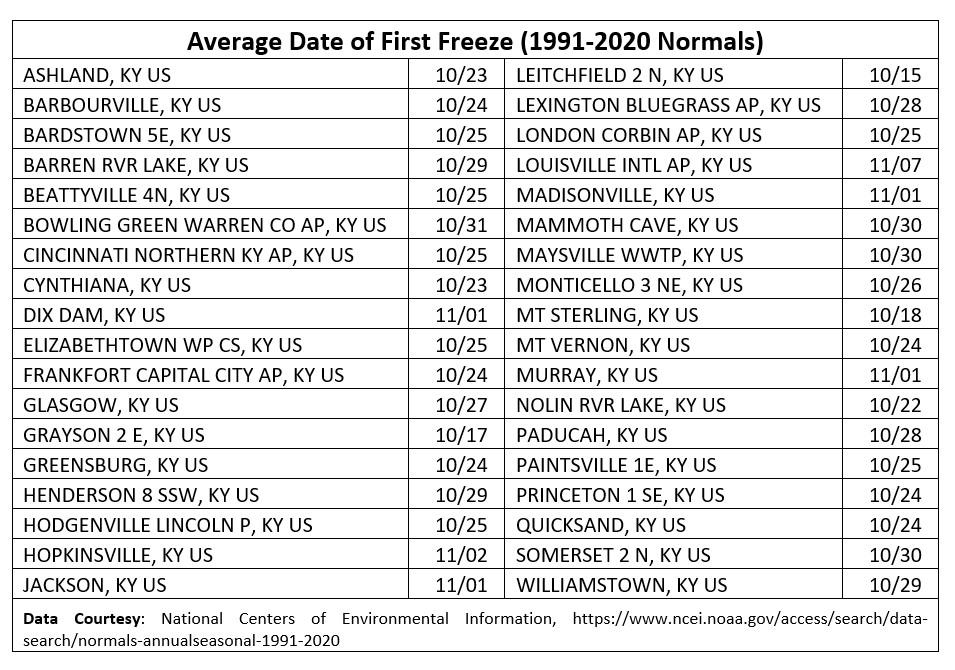
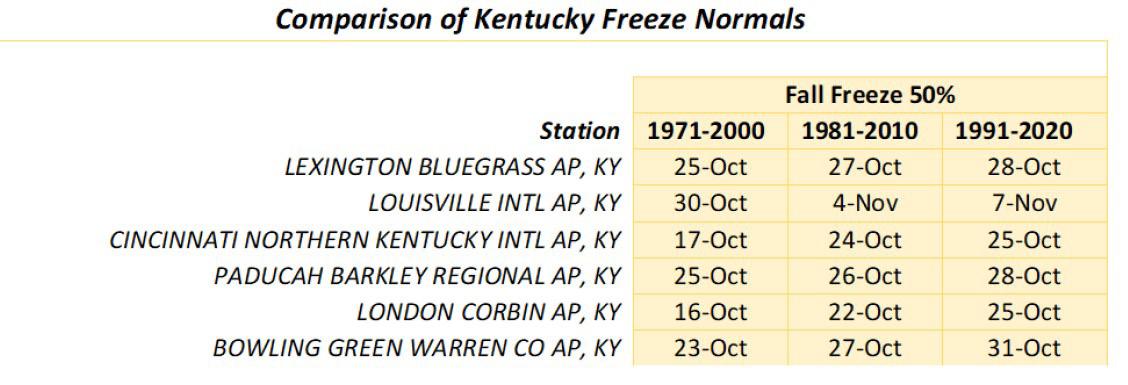
IMAGES COURTEY MATT DIXON, METEOROLOGIST.
| Source: University of Kentucky Ag Weather Update by Matt Dixon, Meteorologist
UK CENTERS SUCCESSFULLY TRAIN AGRICULTURAL COMMUNITY MEMBERS TO RECOGNIZE SIGNS OF MENTAL DISTRESS
Agricultural work can be a source of stress, anxiety and depression due to its unpredictability and physical and mental demands. University of Kentucky College of Agriculture, Food and Environment researchers are helping train Kentuckians to recognize signs of mental distress in members of their local agricultural community. The program is seeing great success. Through the college’s Southeast Center for Agricultural Health and Injury Prevention and the Central Appalachian Regional Education and Research Center, Kentuckians who regularly interact with farmers and rural health care providers are learning Question-Persuade-Refer. QPR is a nationally recognized suicide prevention program that helps individuals recognize when someone is facing mental hardship and connect them with health care professionals. UK researchers took the existing QPR program and developed additional materials to help participants identify farm-related stressors and agriculture-specific behavioral clues that may indicate a farmer is going through a difficult time. “When the 2018 federal farm bill appropriated money for mental health services for farmers, it really opened up the conversation about mental health in the agricultural community almost overnight,” said Joan Mazur, PhD, professor and deputy director of the Southeast Center for Agricultural Health and Injury Prevention. “People really seem to appreciate the opportunity to talk about mental health, use the word suicide and have conversations about struggles they see in their communities.” During the summer of 2020, with support from a U.S. Department of Agriculture’s Agrisafe subaward, the Southeast Center trained 17 certified QPR Institute trainers who, in turn, used those skills to train 415 Kentuckians as part of their Agricultural Community QPR for Farmers and Farm Families program. “We really wanted to leverage this important policy ‘moment’ and develop a community-based support network to address this difficult issue,” Mazur said. “We asked people to participate who we knew were already embedded in rural agricultural communities, working with farmers on a regular basis and who really cared about farmers’ mental health. We wanted to find ways to break down the boundaries that farmers can put up.” Alethea Bruzek, UK Cooperative Extension Service agent, was among the UK and Kentucky State University extension agents and faculty members initially trained in QPR. Since being trained, she has trained others. “I have a unique opportunity to reach farm families through my work in extension,” said Bruzek, Boyle County family and consumer sciences extension agent. “This training gave me the tools that I need to start a conversation with someone in my local farming community, who may be struggling. It was a great chance for me to try to help.” The centers received additional support from the 2020-2021 Kentucky Legislature through an effort championed by Kentucky Rep. Brandon Reed. The legislature’s allocation provided funding for 40 more QPR trainers to train an additional 300 Kentuckians in the Kentucky Rural Mental Health and Suicide Prevention pilot program. The second cohort of participants are located in counties with high
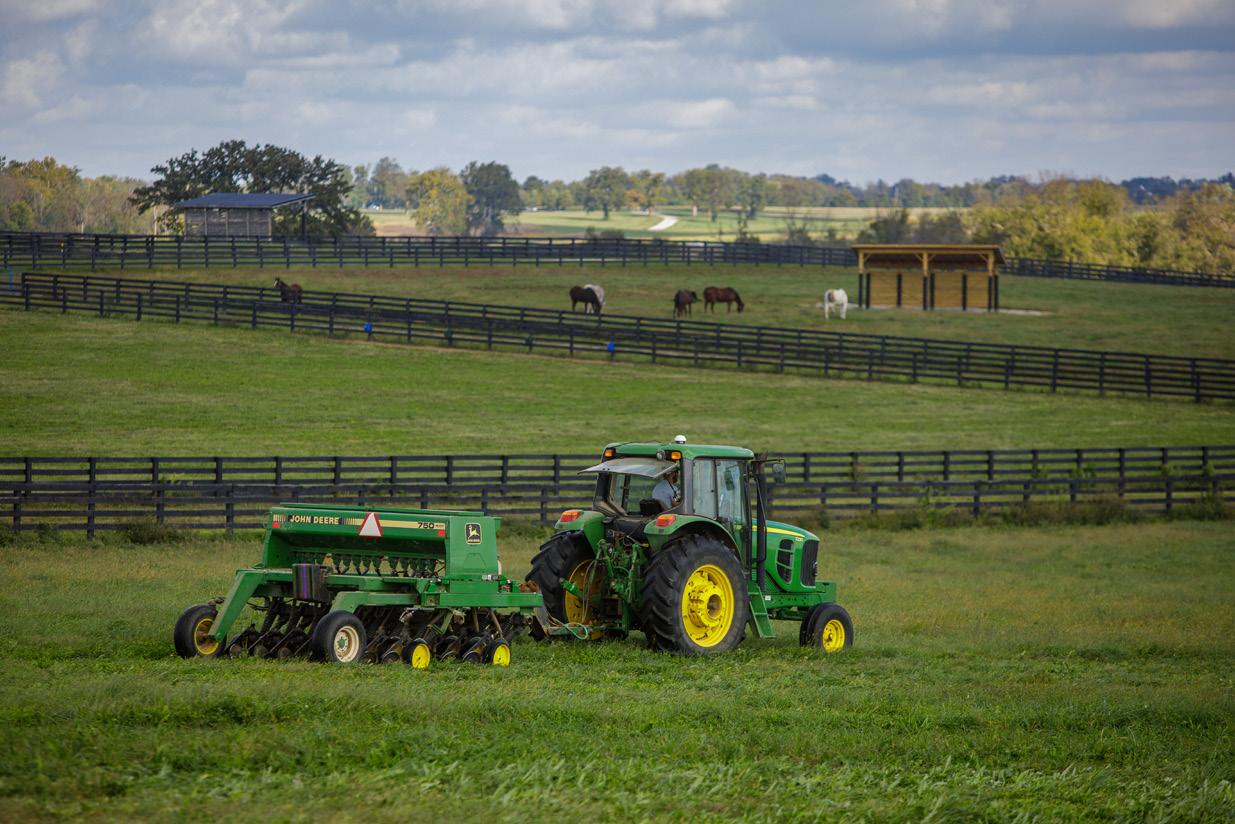
PHOTO COURTESY UK COLLEGE OF AGRICULTURE, FOOD AND ENVIRONMENT.
needs for these services. They live in areas with high rates of morbidity and mortality and a large number of farms. “It is extremely rare to have support from a state legislature to address rural mental health, and we are so appreciative that our legislators have made this issue a priority,” Mazur said. The centers are also studying the effectiveness of the trainings. In the first group of participants, UK researchers surveyed them three days before and one month after the training. “Our findings show that the training had a statistically significant impact upon trainees. After the training, participants were twice as willing to intervene with someone who needs help,” said Carolyn Oldham, MSEd, PhD, director of continuing education for the Central Appalachian Regional Education and Research Center. “In our first group of trainers, two had actually intervened with a producer within the first month after learning QPR.” The second cohort of participants is in the midst of training. Researchers will survey this group at one month, six months and one year after they complete the program. The researchers are also working with the Kentucky Injury Prevention and Research Center to upgrade the state’s suicide hotline so when a Kentuckian calls it, a fellow Kentuckian answers the phone. Callers to the Kentucky hotline are also asked if they are a farmer or member of a farm family, which will allow researchers to track mental health issues in rural communities. The Southeast Center for Agricultural Health and Injury Prevention and the Central Appalachian Regional Research and Education Center are funded by the National Institute for Occupational Health and Safety and directed by Wayne Sanderson, PhD, CIH, a professor in the UK Department of Biosystems and Agricultural Engineering. Plans are underway for the project to build on the Kentucky model and extend and expand their agricultural community-based QPR train-the-trainer model to other Southeastern states the center serves. The center also developed a video that highlights the importance of suicide prevention education and features some participants from the first co-hort. It is available online here.
| Katie Pratt is an agricultural communications specialist in the University of Kentucky’s College of Agriculture, Food and Environment.




